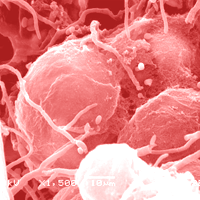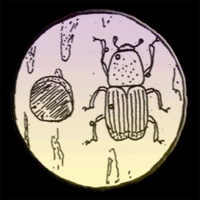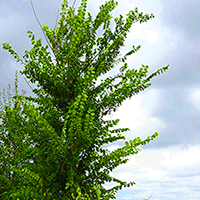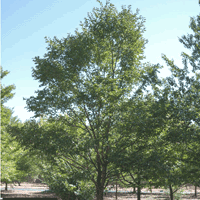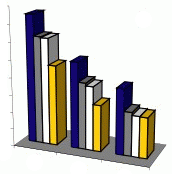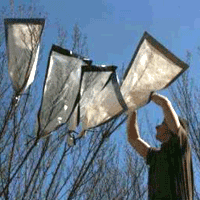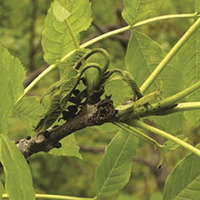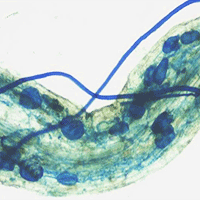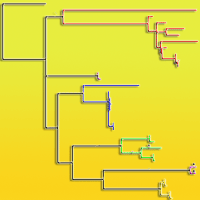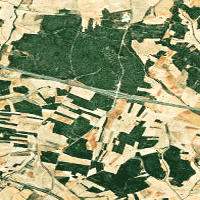During the last decades, the development of ever more powerful genetic, molecular and omic approaches has provided plant pathologists with a wide array of experimental tools for elucidating the intricacies of plant-pathogen interactions and proposing new control strategies. In the case of the Dutch elm disease (DED) pathosystem, these tools have been applied for advancing knowledge of the host (Ulmus spp.) and the causal agents (Ophiostoma ulmi, O. novo-ulmi and O. himal-ulmi). Genetic and molecular analyses have led to the identification, cloning and characterization of a few genes that contribute to parasitic fitness in the pathogens. Quantitative PCR and high-throughput methods, such as expressed sequence tag analysis, have been used for measuring gene expression and identifying subsets of elm genes that are differentially expressed in the presence of O. novo-ulmi. These analyses have also helped identify genes that were differentially expressed in DED fungi grown under defined experimental conditions. Until recently, however, functional analysis of the DED fungi was hampered by the lack of protocols for efficient gene knockout and by the unavailability of a full genome sequence. While the selective inactivation of Ophiostoma genes by insertional mutagenesis remains a challenge, an alternative approach based on RNA interference is now available for down-regulating the expression of targeted genes. In 2013, the genome sequences of O. ulmi and O. novo-ulmi were publicly released. The ongoing annotation of these genomes should spark a new wave of interest in the DED pathosystem, as it should lead to the formal identification of genes modulating parasitic fitness. A better understanding of DED, however, also requires that omic approaches are applied to the study of the other biotic components of this pathosystem.
Keywords
, , , ,
Citation
Bernier L, Aoun M, Bouvet GF, Comeau A, Dufour J, Naruzawa ES, Nigg M, Plourde KV (2015). Genomics of the Dutch elm disease pathosystem: are we there yet?. iForest 8: 149-157. - doi: 10.3832/ifor1211-008
Academic Editor
Alberto Santini
Paper history
Received: Dec 23, 2013
Accepted: May 03, 2014
First online: Aug 07, 2014
Publication Date: Apr 01, 2015
Publication Time: 3.20 months
© SISEF - The Italian Society of Silviculture and Forest Ecology 2015
Open Access
This article is distributed under the terms of the Creative Commons Attribution-Non Commercial 4.0 International (https://creativecommons.org/licenses/by-nc/4.0/), which permits unrestricted use, distribution, and reproduction in any medium, provided you give appropriate credit to the original author(s) and the source, provide a link to the Creative Commons license, and indicate if changes were made.

Breakdown by View Type
(Waiting for server response...)
Article Usage
Total Article Views: 57989
(from publication date up to now)
Breakdown by View Type
HTML Page Views: 48097
Abstract Page Views: 3977
PDF Downloads: 4322
Citation/Reference Downloads: 41
XML Downloads: 1552
Web Metrics
Days since publication: 4147
Overall contacts: 57989
Avg. contacts per week: 97.88
Article Citations
Article citations are based on data periodically collected from the Clarivate Web of Science web site
(last update: Mar 2025)
Total number of cites (since 2015): 13
Average cites per year: 1.18
Publication Metrics
by Dimensions ©
Articles citing this article
List of the papers citing this article based on CrossRef Cited-by.
(1)
Aoun M, Rioux D, Simard M, Bernier L (2009)Colonization and defense reactions in
Ulmus americana callus cultures inoculated with
Ophiostoma novo-ulmi. Phytopathology 99: 642-650.
CrossRef |
Gscholar
(2)
Aoun M, Jacobi V, Boyle B, Bernier L (2010)Identification and monitoring of
Ulmus americana transcripts during
in vitro interactions with the Dutch elm disease pathogen
Ophiostoma novo-ulmi. Physiological and Molecular Plant Pathology 74: 254-266.
CrossRef |
Gscholar
(3)
Barakat A, DiLoreto DS, Zhang Y, Smith C, Baier K, Powell W, Wheeler N, Sederoff R, Carlson JE (2009)Comparison of transcriptome from cankers and healthy stems in American chestnut (
Castanea dentata) and Chinese chestnut (
Castanea mollissima). BMC Plant Biology 9: 51.
CrossRef |
Gscholar
(4)
Bates MR, Buck KW, Brasier CM (1993)Molecular relationships between
Ophiostoma ulmi and the NAN and EAN races of
O. novo-ulmi determined by restriction fragment length polymorphisms of nuclear DNA. Mycological Research 97: 449-455.
CrossRef |
Gscholar
(5)
Bernier L, Hubbes M (1990a)Mutations in
Ophiostoma ulmi induced by N-methyl-N’-nitro-N-nitrosoguanidine. Canadian Journal of Botany 68: 225-231.
CrossRef |
Gscholar
(6)
Bernier L, Hubbes M (1990b)Meiotic analysis of induced mutations in
Ophiostoma ulmi. Canadian Journal of Botany 68: 232-235.
CrossRef |
Gscholar
(7)
Beyhan S, Gutierrez M, Voorhies M, Sil A (2013)A temperature-responsive network links cell shape and virulence traits in a primary fungal pathogen. PLoS Biology 11: e1001614.
CrossRef |
Gscholar
(8)
Binz T, Jalali F, Horgen PA (1998)Isolation of adenylate cyclase gene-specific sequences from
Ophiostoma novo-ulmi, Candida albicans, and
Agaricus bisporus by PCR. Current Microbiology 37: 359-361.
CrossRef |
Gscholar
(9)
Blomquist GJ, Figueroa-Teran R, Aw M, Song M, Gorzalski A, Abbott NL, Chang E, Tittiger C (2010)Pheromone production in bark beetles. Insect Biochemistry and Molecular Biology 40: 699-712.
CrossRef |
Gscholar
(10)
Bouvet GF, Jacobi V, Bernier L (2007)Characterization of three DNA transposons in the Dutch elm disease fungi and evidence of repeat-induced point (RIP) mutations. Fungal Genetics and Biology 44: 430-443.
CrossRef |
Gscholar
(11)
Bouvet GF, Jacobi V, Plourde KV, Bernier L (2008)Stress-induced mobility of OPHIO1 and OPHIO2, DNA transposons of the Dutch elm disease fungi. Fungal Genetics and Biology 45: 565-578.
CrossRef |
Gscholar
(12)
Bowden CG, Hintz WE, Jeng RS, Hubbes M, Horgen PA (1994)Isolation and characterization of the cerato-ulmin gene of the Dutch elm disease pathogen,
Ophiostoma ulmi. Current Genetics 25: 323-329.
CrossRef |
Gscholar
(13)
Bowden CG, Smalley E, Guries RP, Hubbes M, Temple B, Horgen PA (1996)Lack of association between cerato-ulmin production and virulence in
Ophiostoma novo-ulmi. Molecular Plant-Microbe Interactions 9: 556-564.
CrossRef |
Gscholar
(14)
Brasier CM (1981)Laboratory investigation of
Ceratocystis ulmi. In “Compendium of elm diseases” (Stipes RJ, Campana RJ eds). American Phytopathological Society, St. Paul, MN, USA, pp. 76-79.
Gscholar
(15)
Brasier CM (1983)A cytoplasmically transmitted disease of
Ceratocystis ulmi. Nature 305 : 220-223.
CrossRef |
Gscholar
(16)
Brasier CM (1988a)Rapid changes in genetic structure of epidemic populations of
Ophiostoma ulmi. Nature 332: 538-541.
CrossRef |
Gscholar
(17)
Brasier CM (1988b)Ophiostoma ulmi, cause of Dutch elm disease. In: “Advances in Plant Pathology, vol. 6” (Sidhu GS ed). Academic Press, New York, USA, pp. 207-223.
Gscholar
(18)
Brasier CM (1991)Ophiostoma novo-ulmi sp.
nov., causative agent of current Dutch elm disease pandemics. Mycopathologia 115: 151-161.
CrossRef |
Gscholar
(19)
Brasier CM (2001)Rapid evolution of introduced plant pathogens via interspecific hybridization. Bioscience 51: 123-33.
CrossRef |
Gscholar
(20)
Brasier CM, Kirk SA (2001)Designation of the EAN and NAN races of
Ophiostoma novo-ulmi as subspecies. Mycological Research 105: 547-554.
CrossRef |
Gscholar
(21)
Brasier CM, Kirk SA (2010)Rapid emergence of hybrids between the two subspecies of
Ophiostoma novo-ulmi with a high level of pathogenic fitness. Plant Pathology 59: 186-199.
CrossRef |
Gscholar
(22)
Brasier CM, Kirk SA, Pipe ND, Buck KW (1998)Rare interspecific hybrids in natural populations of the Dutch elm disease pathogens
Ophiostoma ulmi and
O. novo-ulmi. Mycological Research 102: 45-57.
CrossRef |
Gscholar
(23)
Brasier CM, Kirk SA, Tegli S (1995)Naturally occurring non ceratoulmin producing mutants of
Ophiostoma novo-ulmi are pathogenic but lack aerial mycelium. Mycological Research 99: 436-440.
CrossRef |
Gscholar
(24)
Brasier CM, Mehrotra MD (1995)Ophiostoma himal-ulmi sp.
nov., a new species of Dutch elm disease fungus endemic to the Himalayas. Mycological Research 99: 205-215.
CrossRef |
Gscholar
(25)
Brunet J, Zalapa JE, Peccori F, Santini A (2013)Patterns of hybridization and introgression between the exotic Siberian elm,
Ulmus pumila, and the native Field elm,
U. minor in Italy. Biological Invasions 15: 2717-2730.
CrossRef |
Gscholar
(26)
Büchel K, McDowell E, Nelson W, Descour A, Gershenzon J, Hilker M, Soderlund C, Gang DR, Fenning T, Meiners T (2012)An elm EST database for identifying leaf beetle egg-induced defense genes. BMC Genomics 13: 242.
CrossRef |
Gscholar
(27)
Carneiro JS, de la Bastide PY, Chabot M, Lerch L, Hintz WE (2010)Suppression of polygalacturonase gene expression in the phytopathogenic fungus
Ophiostoma novo-ulmi by RNA interference. Fungal Genetics and Biology 47: 399-405.
CrossRef |
Gscholar
(28)
Carneiro JS, de la Bastide PY, Hintz WE (2013)Regulated gene silencing in the fungal pathogen
Ophiostoma novo-ulmi. Physiological and Molecular Plant Pathology 82: 28-34.
CrossRef |
Gscholar
(29)
Coleman M, Hollingsworth ML, Hollingsworth PM (2000)Application of RAPDs to the critical taxonomy of the English endemic elm
Ulmus plotii Druce. Botanical Journal of the Linnean Society 133: 241-262.
CrossRef |
Gscholar
(30)
Corchete MP, Diez JJ, Valle T (1993)Phenylalanine ammonialyase activity in suspension cultures of
Ulmus pumila and
U. campestris treated with spores of
Ceratocystis ulmi. Plant Cell Reports 13: 111-114.
CrossRef |
Gscholar
(31)
Croucher PJP, Mascheretti S, Garbelotto M (2013)Combining field epidemiological information and genetic data to comprehensively reconstruct the invasion history and the microevolution of the sudden oak death agent
Phytophthora ramorum (Stramenopila: Oomycetes) in California. Biological Invasions 15: 2281-2297.
CrossRef |
Gscholar
(32)
Debuchy R, Turgeon BG (2006)Mating-type structure, evolution, and function in Euascomycetes. In: “The Mycota I (2nd edn). Growth, Differentation and Sexuality” (Kües U, Fischer R eds). Springer-Verlag, Berlin & Heidelberg, Germany, pp. 293-323.
Gscholar
(33)
Dewar K, Bernier L (1995)Inheritance patterns of nonhomologous chromosomes in
Ophiostoma ulmi sensu lato. Current Genetics 27: 541-549.
CrossRef |
Gscholar
(34)
Dewar K, Bousquet J, Dufour J, Bernier L (1997)A meiotically reproducible chromosome length polymorphism in the ascomycete fungus
Ophiostoma ulmi (sensu lato). Molecular and General Genetics 255: 38-44.
CrossRef |
Gscholar
(35)
DiGuistini S, Liao NY, Platt D, Robertson G, Seidel M, Chan SK, Roderick Docking T, Birol I, Holt RA, Hirst M, Mardis E, Marra MA, Hamelin RC, Bohlmann J, Breuil C, Jones SJM (2009)De novo genome sequence assembly of a filamentous fungus using Sanger, 454 and Illumina sequence data. Genome Biology 10: R94.
Online |
Gscholar
(36)
Duplessis S, Hacquard S, Delaruelle C, Tisserant E, Frey P, Martin F, Kohler A (2011)Melampsora larici-populina transcript profiling during germination and timecourse infection of poplar leaves reveals dynamic expression patterns associated with virulence and biotrophy. Molecular Plant-Microbe Interactions 24: 808-818.
CrossRef |
Gscholar
(37)
Et-Touil A, Brasier CM, Bernier L (1999)Localization of a pathogenicity gene in
Ophiostoma novo-ulmi and evidence that it may be introgressed from
O. ulmi. Molecular Plant-Microbe Interactions 12: 6-15.
CrossRef |
Gscholar
(38)
Et-Touil A, Rioux D, Mathieu F, Bernier L (2005)External symptoms and histopathological changes following inoculation of genetically close strains of
Ophiostoma to elms putatively resistant to Dutch elm disease. Canadian Journal of Botany 83: 656-667.
CrossRef |
Gscholar
(39)
Forgetta V, Leveque G, Dias J, Grove D, Lyons Jr R, Genik S, Wright C, Singh S, Peterson N, Zianni M, Kieleczawa J, Hintz W, Jacobi V, Bernier L, Levesque R, Dewar K (2013)Comparison of multiple genome sequencing centers and analysis of the Dutch elm disease fungus genome Using the Roche/454 GS-FLX Titanium System. Journal of Biomolecular Techniques 24: 39-49.
Online |
Gscholar
(40)
Fulbright DW (1984)Effect of eliminating dsRNA in hypovirulent
Endothia parasitica. Phytopathology 74: 722-724.
CrossRef |
Gscholar
(41)
Gagné P, Yang DQ, Hamelin RC, Bernier L (2001)Genetic variability of Canadian populations of the sapstain fungus
Ophiostoma piceae. Phytopathology 91: 369-376.
CrossRef |
Gscholar
(42)
Gartland KMA, McHugh AT, Crow RM, Garg A, Gartland JS (2005)Biotechnological progress in dealing with Dutch elm disease. In Vitro Cellular and Developmental Biology-Plant 41: 364-367.
CrossRef |
Gscholar
(43)
Gayathri Samarasekera GDN, Bartell NV, Lindgren BS, Cooke, JEK, Davis CS, James PMA, Coltman DW, Mock KE, Murray BW (2012)Spatial genetic structure of the mountain pine beetle (
Dendroctonus ponderosae) outbreak in western Canada: historical patterns and contemporary dispersal. Molecular Ecology 21: 2931-2948.
CrossRef |
Gscholar
(44)
Gil L, Fuentes-Utrilla P, Soto A, Cervera MT, Collada C (2004)English elm is a 2000-year-old Roman clone. Nature 431: 1053.
CrossRef |
Gscholar
(45)
Goodall-Copestake WP, Hollingsworth ML, Hollingsworth PM, Jenkins GI, Collin E (2005)Molecular markers and
ex situ conservation of the European elms (
Ulmus spp.). Biological Conservation 122: 537-546.
CrossRef |
Gscholar
(46)
Haran J, Timmermans MJTN, Vogler AP (2013)Mitogenome sequences stabilize the phylogenetics of weevils (Curculionoidea) and establish the monophyly of larval ectophagy. Molecular Phylogenetics and Evolution 67: 156-166.
CrossRef |
Gscholar
(47)
Haridas S, Wang Y, Lim L, Massoumi Alamouti S, Jackman S, Docking R, Robertson G, Birol I, Bohlmann J, Breuil C (2013)The genome and transcriptome of the pine saprophyte
Ophiostoma piceae, and a comparison with the bark beetle-associated pine pathogen
Grosmannia clavigera. BMC Genomics 14: 373.
CrossRef |
Gscholar
(48)
Hintz WE (1999)Sequence analysis of the chitin synthase A gene of the Dutch elm pathogen
Ophiostoma novo-ulmi indicates a close association with the human pathogen
Sporothrix schenckii. Gene 237: 215-221.
CrossRef |
Gscholar
(49)
Hintz WE, Jeng RS, Hubbes M, Horgen PA (1991)Identification of three populations of
Ophiostoma ulmi (aggressive subgroup) by mitochondrial DNA restriction-site mapping and nuclear DNA fingerprinting. Experimental Mycology 15: 316-325.
CrossRef |
Gscholar
(50)
Hintz W, Pinchback M, de la Bastide P, Burgess S, Jacobi V, Hamelin R, Breuil C, Bernier L (2011)Functional categorization of unique expressed sequence tags obtained from the yeast-like growth phase of the elm pathogen
Ophiostoma novo-ulmi. BMC Genomics 12: 431.
CrossRef |
Gscholar
(51)
Hintz W, Carneiro JS, Kassatenko I, Varga A, James D (2013)Two novel mitoviruses from a Canadian isolate of the Dutch elm pathogen
Ophiostoma novo-ulmi (93-1224). Virology Journal 10: 252.
CrossRef |
Gscholar
(52)
Hoegger PJ, Binz T, Heiniger U (1996)Detection of genetic variation between
Ophiostoma ulmi and the NAN and EAN races of
O. novo-ulmi in Switzerland using RAPD markers. European Journal of Forest Pathology 26: 57-68.
CrossRef |
Gscholar
(53)
Houston DR (1991)Changes in aggressive and nonaggressive subgroups of
Ophiostoma ulmi within two populations of American elm in New England. Plant Disease 75: 720-722.
CrossRef |
Gscholar
(54)
Jacobi V, Dufour J, Bouvet GF, Aoun M, Bernier L (2010)Identification of transcripts upregulated in asexual and sexual fruiting bodies of the Dutch elm disease pathogen
Ophiostoma novo-ulmi. Canadian Journal of Microbiology 56: 697-705.
CrossRef |
Gscholar
(55)
Jeng RS, Alfenas AC, Hubbes M, Dumas M (1983)Presence and accumulation of fungitoxic substances against
Ceratocystis ulmi in
Ulmus americana: possible relation to induced resistance. European Journal of Forest Pathology 13: 239-244.
CrossRef |
Gscholar
(56)
Jeng RS, Duchesne LC, Sabourin M, Hubbes M (1991)Mitochondrial DNA restriction fragment length polymorphisms of aggressive and non-aggressive isolates of
Ophiostoma ulmi. Mycological Research 95: 537-542.
CrossRef |
Gscholar
(57)
Jordal BH, Sequeira AS, Cognato AI (2011)The age and phylogeny of wood boring weevils and the origin of subsociality. Molecular Phylogenetics and Evolution 59: 708-724.
CrossRef |
Gscholar
(58)
Keeling CI, Henderson H, Li M, Yuen M, Clark EL, Fraser JD, Huber DPW, Liao NY, Docking TR, Birol I, Chan SK, Taylor GA, Palmquist D, Jones SJM, Bohlmann J (2012)Transcriptome and full-length cDNA resources for the mountain pine beetle,
Dendroctonus ponderosae Hopkins, a major insect pest of pine forests. Insect Biochemistry and Molecular Biology 42: 525-536.
CrossRef |
Gscholar
(59)
Kelkar YD, Ochman H (2012)Causes and consequences of genome expansion in fungi. Genome Biology and Evolution 4: 13-23.
CrossRef |
Gscholar
(60)
Khoshraftar S, Hung S, Khan S, Gong Y, Tyagi V, Parkinson J, Sain M, Moses AM, Christendat D (2013)Sequencing and annotation of the
Ophiostoma ulmi genome. BMC Genomics 14: 162.
CrossRef |
Gscholar
(61)
Konrad H, Kirisits T, Riegler M, Halmschlager E, Stauffer C (2002)Genetic evidence for natural hybridisation between the Dutch elm disease pathogens
Ophiostoma novo-ulmi ssp.
novo-ulmi and
Ophiostoma novo-ulmi ssp.
americana. Plant Pathology 51: 78-4.
CrossRef |
Gscholar
(62)
Kremer A, Abbott AG, Carlson JE, Manos PS, Plomion C, Sisco P, Staton ME, Ueno S, Vendramin GG. (2012)Genomics of Fagaceae. Tree Genetics and Genomes 8: 583-610.
CrossRef |
Gscholar
(63)
Kulkarni RK, Nickerson KW (1981)Nutritional control of dimorphism in
Ceratocystis ulmi. Experimental Mycology 5: 148-154.
CrossRef |
Gscholar
(64)
Masuya H, Brasier C, Ichihara Y, Kubonoa T, Kanzaki N (2010)First report of the Dutch elm disease pathogens
Ophiostoma ulmi and
O. novo-ulmi in Japan. Plant Pathology 59: 805.
CrossRef |
Gscholar
(65)
McLeod G, Gries R, von Reuß SH, Rahe JE, McIntosh R, König WA, Gries G (2005)The pathogen causing Dutch elm disease makes host trees attract insect vectors. Proceedings of the Royal Society B-Biological Sciences 272: 2499-2503
CrossRef |
Gscholar
(66)
Misaghi IJ (1982)The role of pathogen produced cell-wall degrading enzymes in infection and damage. In: “Physiology and Biochemistry of Plant Pathogen Interactions” (Misaghi IJ ed). Plenum Press, New York, USA, pp. 17-34.
Gscholar
(67)
Mittempergher L, Santini A (2004)The history of elm breeding. Investigacion Agraria, Sistemas y Recursos Forestales 13: 161-177.
Gscholar
(68)
Mock KE, Bentz BJ, O’Neill EM, Chong P, Orwin J, Pfrender ME (2007)Landscape-scale genetic variation in a forest outbreak species, the mountain pine beetle (
Dendroctonus ponderosae). Molecular Ecology 16: 553-568.
CrossRef |
Gscholar
(69)
Moser JC, Konrad H, Blomquist SR, Kirisits T (2010)Do mites phoretic on elm bark beetles contribute to the transmission of Dutch elm disease? Naturwissenschaften 97: 219-227.
CrossRef |
Gscholar
(70)
Nasmith C, Jeng R, Hubbes M (2008a)Targeted gene analysis in
Ulmus americana and
U. pumila tissues. Forest Pathology 38: 90-103.
CrossRef |
Gscholar
(71)
Nasmith C, Jeng R, Hubbes M (2008b)A comparison of in vivo targeted gene expression during fungal colonization of DED-susceptible
Ulmus americana. Forest Pathology 38: 104-112.
CrossRef |
Gscholar
(72)
Newhouse AE, Schrodt F, Liang H, Maynard CA, Powell WA (2007)Transgenic American elm shows reduced Dutch elm disease symptoms and normal mycorrhizal colonization. Plant Cell Reports 26: 977-987.
CrossRef |
Gscholar
(73)
Ninomiya Y, Suzuki K, Ishii C, Inoue H (2004)Highly efficient gene replacements in
Neurospora strains deficient for nonhomologous end-joining. Proceedings of the National Academy of Sciences USA 101: 12248-12253.
CrossRef |
Gscholar
(74)
Nordin JH, Strobel GA (1981)Structural and immunochemical studies on the phytotoxic peptidorhamnomannan of
Ceratocystis ulmi. Plant Physiology 67: 1208-1213.
CrossRef |
Gscholar
(75)
Paoletti M, Buck KW, Brasier CM (2005)Cloning and sequence analysis of the MAT-B (MAT-2) genes from the three Dutch elm disease pathogens,
Ophiostoma ulmi, O.novo-ulmi, and
O. himal-ulmi. Mycological Research 109: 983-991.
CrossRef |
Gscholar
(76)
Paoletti M, Buck KW, Brasier CM (2006)Selective acquisition of novel mating type and vegetative incompatibility genes via interspecies gene transfer in the globally invading eukaryote
Ophiostoma novo-ulmi. Molecular Ecology 15: 249-262.
CrossRef |
Gscholar
(77)
Pereira V, Royer JC, Hintz WE, Field D, Bowden C, Kokurewicz K, Hubbes M, Horgen PA (2000)A gene associated with filamentous growth in
Ophiostoma novo-ulmi has RNA-binding motifs and is similar to a yeast gene involved in mRNA splicing. Current Genetics 37: 94-103.
CrossRef |
Gscholar
(78)
Pijut PM, Lineberger RD, Domir SC, Ichida JM, Krause CR (1990)Ultrastructure of cells of
Ulmus americana cultured
in vitro and exposed to the culture filtrate of
Ceratocystis ulmi. Phytopathology 80: 764-767.
CrossRef |
Gscholar
(79)
Plourde KV, Bernier L (2014)Inoculation of apple (
Malus x domestica “Golden Delicious”) fruits provides a rapid virulence assay for the Dutch elm disease fungus
Ophiostoma novo-ulmi. Plant Pathology.
CrossRef |
Gscholar
(80)
Plourde KV, Jacobi V, Bernier L (2008)Use of insertional mutagenesis to tag putative parasitic fitness genes in the Dutch elm disease fungus
Ophiostoma novo-ulmi subsp.
novo-ulmi. Canadian Journal of Microbiology 54: 797-802.
CrossRef |
Gscholar
(81)
Richards WC (1994)Nonsporulation in the Dutch elm disease fungus
Ophiostoma ulmi: evidence for control by a single nuclear gene. Canadian Journal of Botany 72: 461-467.
CrossRef |
Gscholar
(82)
Royer JC, Dewar K, Hubbes M, Horgen PA (1991)Analysis of a high frequency transformation system for
Ophiostoma ulmi, the causal agent of Dutch elm disease. Molecular and General Genetics 225: 168-176.
CrossRef |
Gscholar
(83)
Santini A, Montaghi A, Vendramin GG, Capretti P (2005)Analysis of the Italian Dutch elm disease fungal population. Journal of Phytopathology 153: 73-79.
CrossRef |
Gscholar
(84)
Sethuraman J, Majer A, Friedrich NC, Edgell DR, Hausner G (2009)Genes within genes: multiple LAGLIDADG homing endonucleases target the ribosomal protein S3 gene encoded within an rnl group I intron of
Ophiostoma and related taxa. Molecular Biology and Evolution 26: 2299-2315.
CrossRef |
Gscholar
(85)
Solla A, Dacasa MC, Nasmith C, Hubbes M, Gil L (2008)Analysis of Spanish populations of
Ophiostoma ulmi and
O. novo-ulmi using phenotypic characteristics and RAPD markers. Plant Pathology 57: 33-44.
CrossRef |
Gscholar
(86)
Staszak AM, Pawlowski TA (2012)Forest tree research in post genomic era. Introduction to systems biology of broadleaves. Dendrobiology 68: 113-123.
Gscholar
(87)
Sutherland ML, Brasier CM (1995)Effect of d-factors on
in vitro cerato-ulmin production by the Dutch elm disease pathogen
Ophiostoma novo-ulmi. Mycological Research 99: 1211-1217.
CrossRef |
Gscholar
(88)
Svaldi R, Elgersma DM (1982)Further studies on the activity of cell wall degrading enzymes of aggressive and non-aggressive isolates of
Ophiostoma ulmi. European Journal of Forest Pathology 12: 29-36.
CrossRef |
Gscholar
(89)
Tadesse Y, Bernier L, Hintz WE, Horgen PA (2003)Real time RT-PCR quantification and Northern analysis of Cerato ulmin (CU) gene transcription in different strains of the phytopathogens
Ophiostoma ulmi and
O. novo ulmi. Molecular Genetics and Genomics 269: 789-796.
CrossRef |
Gscholar
(90)
Takai S (1980)Relationship of the production of the toxin, cerato-ulmin, to synnemata formation, pathogenicity, mycelial habit, and growth of
Ceratocystis ulmi isolates. Canadian Journal of Botany 58: 658-662.
CrossRef |
Gscholar
(91)
Temple B, Horgen PA, Bernier L, Hintz WE (1997)Cerato-ulmin, a hydrophobin secreted by the causal agents of Dutch elm disease, is a parasitic fitness factor. Fungal Genetics and Biology 22: 39-53.
CrossRef |
Gscholar
(92)
Temple B, Pines PA, Hintz WE (2006)A nine-year genetic survey of the causal agent of Dutch elm disease,
Ophiostoma novo-ulmi, in Winnipeg, Canada. Mycological Research 110: 594-600.
CrossRef |
Gscholar
(93)
Temple B, Bernier L, Hintz WE (2009)Characterization of the polygalacturonase gene of the Dutch elm disease pathogen
Ophiostoma novo-ulmi. New Zealand Journal of Forestry Science 39: 29-37.
Online |
Gscholar
(94)
Tsui CKM, Roe AD, El-Kassaby YA, Rice AV, Alamouti SM, Sperling FAH, Cooke JEK, Bohlmann J, Hamelin RC (2012)Population structure and migration pattern of a conifer pathogen,
Grosmannia clavigera, as influenced by its symbiont, the mountain pine beetle. Molecular Ecology 21: 71-86.
CrossRef |
Gscholar
(95)
Vakkari P, Rusanen M, Kärkkäinen K (2009)High genetic differentiation in marginal populations of European white elm (
Ulmus laevis). Silva Fennica 43: 185-196.
CrossRef |
Gscholar
(96)
Venturas M, Fuentes-Utrilla P, Ennos R, Collada C, Gil L (2013)Human-induced changes on fine-scale genetic structure in
Ulmus laevis Pallas wetland forests at its SW distribution limit. Plant Ecology 214: 317-327.
CrossRef |
Gscholar
(97)
Webber JF (1990)Relative effectiveness of
Scolytus scolytus, S. multistriatus, and
S. kirschi as vectors of Dutch elm disease. European Journal of Forest Pathology 20: 184-192.
CrossRef |
Gscholar
(98)
Webber JF (2004)Experimental studies on factors influencing the transmission of Dutch elm disease. Investigacion Agraria, Sistemas y Recursos Forestales 13: 197-205.
Gscholar
(99)
Whiteley RE, Black-Samuelsson S, Jansson G (2003)Within and between population variation in adaptive traits in
Ulmus laevis Pall., the European white elm. Forest Genetics 10: 313-323.
Gscholar
(100)
Wiegrefe SJ, Sytsma KJ, Guries RP (1994)Phylogeny of elms (
Ulmus, Ulmaceae): molecular evidence for a sectional classification. Systematic Botany 19: 590-612.
CrossRef |
Gscholar
(101)
Zalapa JE, Brunet J, Guries RP (2008)Genetic diversity and relationships among Dutch elm disease tolerant
Ulmus pumila L. accessions from China. Genome 51: 492-500.
CrossRef |
Gscholar
(102)
Zalapa JE, Brunet J, Guries RP (2010)The extent of hybridization and its impact on the genetic diversity and population structure of an invasive tree,
Ulmus pumila (Ulmaceae). Evolutionary Applications 3: 157-168.
CrossRef |
Gscholar
